Poultry has been domesticated for thousands of years, and there are hundreds of types of chickens.
They are a species of domesticated junglefowl, and there are more chickens on the globe than any other type of bird.
Keeping backyard chickens is a popular hobby, but there are many different types of chickens to choose from.
Learn more about selecting suitable chicken breeds so you choose the best kind for your setup.
With all the chicken types available, it can be confusing to know what to get.
To avoid health issues or challenging behavior in your flock, it is essential to choose the right breed to fit your requirements, climate, and coop setup.

What Is A Chicken?
Most poultry owners will tell you that chickens are tiny dinosaurs, and they are not far off.
The way chickens run, scramble to grab food, and eat almost anything edible they find is very reminiscent of tiny prehistoric creatures.
Although there are many types of chickens, they all fall into the scientific classification Gallus gallus domesticus.
Even though chickens have been living with humans for at least 8000 years, they are still closely related to wild junglefowl that can still be found in Southeast Asia.
Chickens are a type of poultry commonly raised to supply eggs, meat, or feathers. More recently, they are also becoming more popular as pets.
There are many different types of chickens, and they can vary greatly in appearance and size. However, in general, chickens have short beaks and wings, with wattles and combs on their heads. They have short legs and round-shaped bodies.
There are a few features that make chickens unique from other birds. Most notable is their inability to fly effectively.
Most chickens can fly enough to get their heavy bodies off the ground and reach a perch, roost, or jump over a fence, but there are no types of chickens that could cover any distance in the air.
All chickens are omnivores and, if they are able to, will actively forage to search for food. Snacks can include anything from tiny seeds to small rodents.
Chickens will also cannibalize each other if one has an open wound.
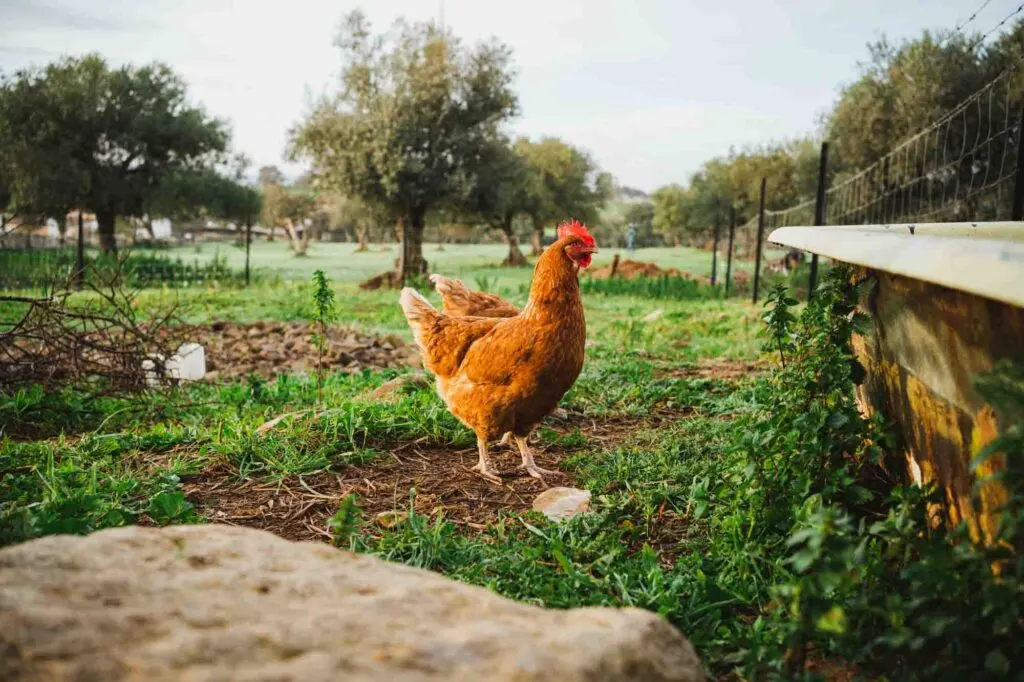
Chicken Types
Since there are hundreds of different types of chickens, it is little wonder that the American Poultry Association has divided them into six groups. These classes usually refer to the region where the breed originated.
When deciding on types of chickens for a setup, it is wise to consider their origin. It provides a lot of background information about the breed. Here’s a quick summary of each class:
American Class
These are thirteen breeds of chickens that originated in the United States or Canada. Heavy, cold hardy types of chickens that lay brown eggs.
Continental Class
Eleven breeds originate from European countries, including Germany, France, Netherlands, and Belgium. Most are energetic birds that are able to move quickly when necessary.
Asiatic Class
Breeds that originate in China. They typically have feathered legs, lay brown eggs, and are large birds.
Mediterranean Class
Breeds that come from Spain and Italy with white earlobes. They also lay white eggs. Excellent free-range birds as they are swift and adept at evading predators.
English Class
These are chicken breeds that originate from the United Kingdom and Australia. These include the popular dual-purpose heavy Australorps and the soft feathery Orpington chickens.
All Other Standard Breeds
Any breed of chickens that doesn’t fit into one of the other five falls into this category. It includes three big categories: Game birds, Oriental and Miscellaneous breeds of chickens like the Ameraucana.
When looking at the classes and the types of chickens that fall under each, you may wonder where the extremely popular Easter Eggers fit in.
This happy-go-lucky breed with the charming name is a hybrid – any mix of breeds could be labeled an Easter Egger as long as it lays pretty colored eggs.
It is, therefore, not included as any actual breed, even though they are hardy and fare well as backyard chickens.

Chicken Terminology
Poultry enthusiasts may use some chicken jargon when talking about their birds, and it may not always be words everyone is familiar with.
Before we move on to looking more closely at some specific chicken types, it is important to understand poultry owner lingo.
Basic terms like hen and rooster are common – they simply refer to any adult female and male chicken.
However, a juvenile hen is often called a pullet, and a young rooster is sometimes called a cockerel. A castrated rooster is called a capon, although this practice is extremely rare in recent times.
Hatchlings are called chicks; after a few months, pullets (young females) reach Point Of Lay (POL). That means they are old enough to start laying and are expected to begin producing eggs soon.
The word broody refers to a condition that hens enter when they want to hatch a clutch of eggs.
Hens often change their personality and become sullen and immobile as they sit patiently on their eggs.
Broodiness can happen even if there is no rooster in a coop to fertilize the eggs, in which case it is essential to break the hen’s broodiness to avoid health issues as she waits in vain for the eggs to hatch.
Another term to look out for is dual-purpose breed, which means that the chicken type is suitable for both meat and egg production – so it is not one or the other.
A good example of this is broilers which grow quickly and have heavy bodies for meat, but they wouldn’t be able to lay as many eggs as most other breeds.
Cold hardiness is also an important element that prospective owners need to keep top of mind.
Only choose cold-hardy birds if you live in areas with freezing winter conditions. There are a lot of hazards associated with extremes of temperature for all types of chickens, but cold hardy birds are more likely to survive harsh winters.
An ornamental chicken is a breed that is prized for its appearance. Chances are good that it may also be a fairly regular layer, but it is unlikely to have a lot of meat.
Bantam-sized chickens are the tiny tots of chicken breeds and are often considered ornamental breeds. They are also a good choice for small backyards.
Bantams are available in most standard breeds but are between half and a third of the size of the standard-size birds.
19 Different Types of Chickens
1. White Rock Chicken

If you have never heard of a White Rock chicken before, it may be because it is a variety of Plymouth Rocks/Barred Rocks that come in a variety of colors, one of which happens to be white. They are, therefore, often referred to as White Plymouth Rock chickens.
White Rock Chickens are an American breed that is a chicken all-star when it comes to delivering a complete package.
The hens are excellent layers, and the meat is tender with pale skin – perfect for roasting.
Adult roosters weigh around 7.5 lbs, and hens are about a pound lighter. The hens don’t often become broody, but they are attentive mothers when they do.
Although White Rock chickens are considered cold-hardy and excellent foragers in free-range settings, they have one rather unfortunate physical disadvantage over many other breeds.
Their snow-white feathers make them highly visible to predators, and they are easy to pick in areas with a lot of birds of prey.
Barred Plymouth Rocks chickens may be a better option in areas with significant danger from predators.
They are highly camouflaged and have all the same excellent characteristics as the White Rock variety.
2. Silkie Chicken
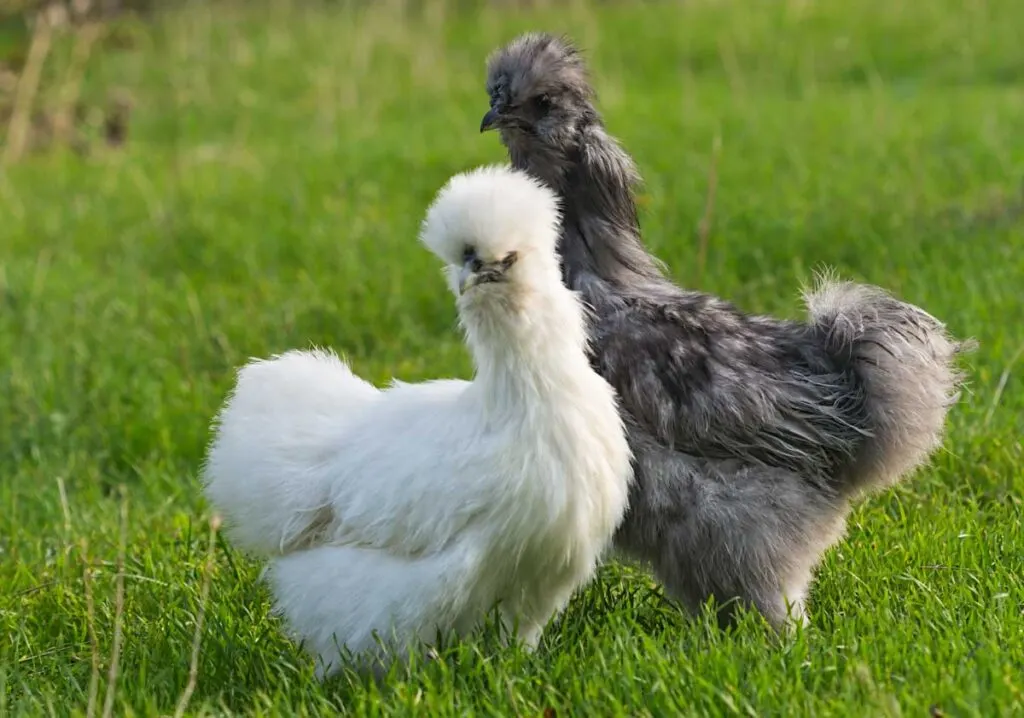
Silkies are an excellent choice if you’d like a chicken breed entirely different from anything else as they are among the weirdest-looking birds.
These unique chickens have soft fluffy feathers and feathered feet that look like strands of silk on their bodies.
They are so different from other types of chickens that early explorers described them as chickens with fur, and one writer mentioned seeing a wool-bearing chicken.
Silkies are small chickens; some even consider them to be bantams. Mature hens weigh around 1.5-2 lbs, and roosters are only marginally heavier at 2-3 lbs.
You can probably tell that Silkies are not the best option if you need chickens as table birds.
In addition to being small, their skin is pitch black, and they have five toes on each foot, while other types of chicken breeds only have four.
Silkies make excellent pets. They are calm and friendly birds, and their unique appearance makes them highly entertaining, attractive pets.
Although they are not prolific layers, hens can lay about three eggs per week. Surprisingly, Silkies can manage in low winter temperatures so long as their satiny soft feathers always stay dry.
3. Barbu d’Uccle Chicken

Poultry owners who own small gardens and want a cute, lovable miniature chicken breed should consider the Barbu d’Uccle chickens, a Belgium bantam breed.
They only come in bantam sizes, and unlike many other chicken breeds, they are usually content to stay within a particular area and don’t wander off too far.
These pint-sized birds originated in Belgium and are one of the rarest types of chickens. It is known as a true bantam because there are no standard sizes of the Barbu d’Uccle – they are all bantams.
Although there are 28 colors listed in their country of origin, the APA only recognizes seven varieties.
Barbu d’Uccle chickens are small yet distinctive in appearance. These bantams have full beards, earmuffs, and their legs are heavily feathered.
Since they are so small, they can’t be described as excellent dual-purpose birds, and the hens’ eggs are tiny.
Owners of Barb d’Uccle chickens are unanimous in their praise of these bantams for their personality.
They are quite simply excellent, cute pet chickens. Adult roosters weigh around 1.6 lbs and hens and 1.3 lbs for hens.
Read next: 17 Rarest Animals Species
4. Brahma Chicken
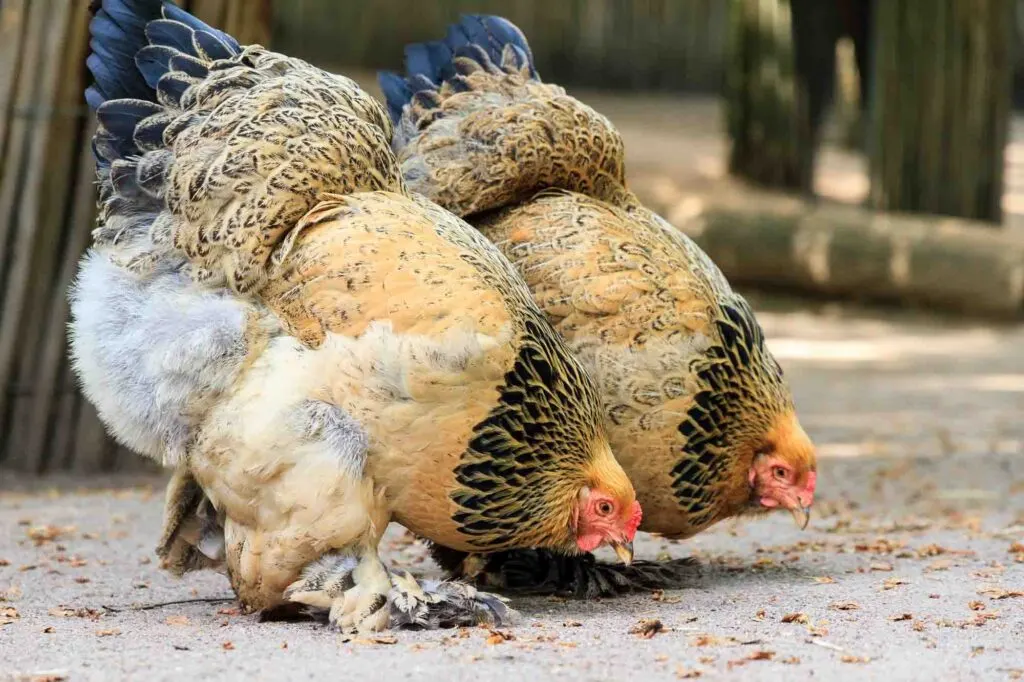
A review of some popular types of chickens is like a mini tour around the world. The Brahma is a giant breed that fits into the Asiatic class of chickens. They are sometimes also called Shanghai chickens.
Brahmas are excellent meat birds that are also cold-hardy and can’t handle hot climates too well.
In fact, in the last half of the 19th century and the start of the 20th century, they were the primary type of meat bird in the United States.
Since they can grow to massive proportions for any chicken type, it is no wonder they were so popular.
Average-size Brahma roosters can tip the scales at around 12 lbs, while hens weigh about 10 lbs.
There have been records of specimens as large as 18 lbs – thankfully, they are known to be calm and gentle birds that make excellent pets for children.
5. Langshan Chicken
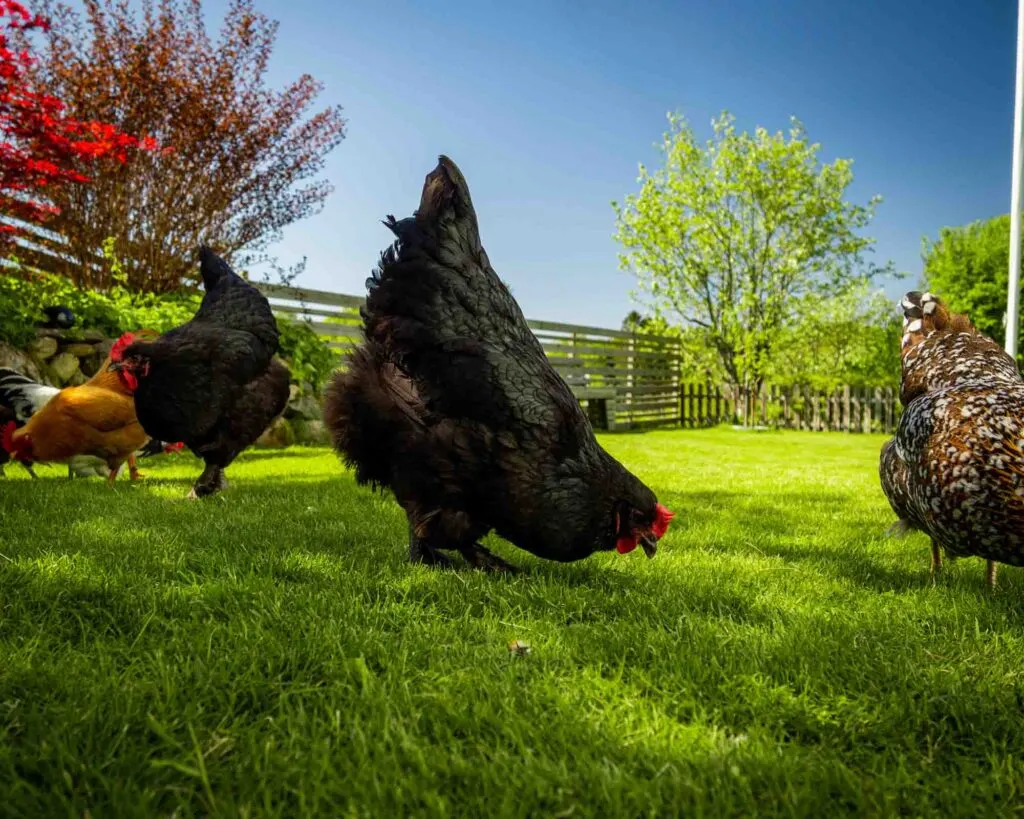
Langshan chickens are an eye-catching Heritage breed that is an excellent choice for owners interested in showing their birds. They come in blue, black, and white varieties.
This chicken type fits into the Asiatic group, so you immediately know it is a heavy breed.
Roosters weigh around 9.5 lbs, and mature hens are about 7.5 lbs. Langshan chickens are excellent dual-purpose birds, and meat is described as rich and flavorful.
The most popular Langshan breed, also called a Croad Langshan, originates in China.
There are also European varieties, most notably the German Langshan, which has longer and consistently clean legs.
Langshan chickens are an excellent choice for poultry owners in the southern states.
Many heavy breeds cannot cope in extreme heat, but according to The Livestock Conservancy, Langshan chickens can manage, so long as they have sufficient shelter from the blazing sun.
6. Rhode Island Red Chicken
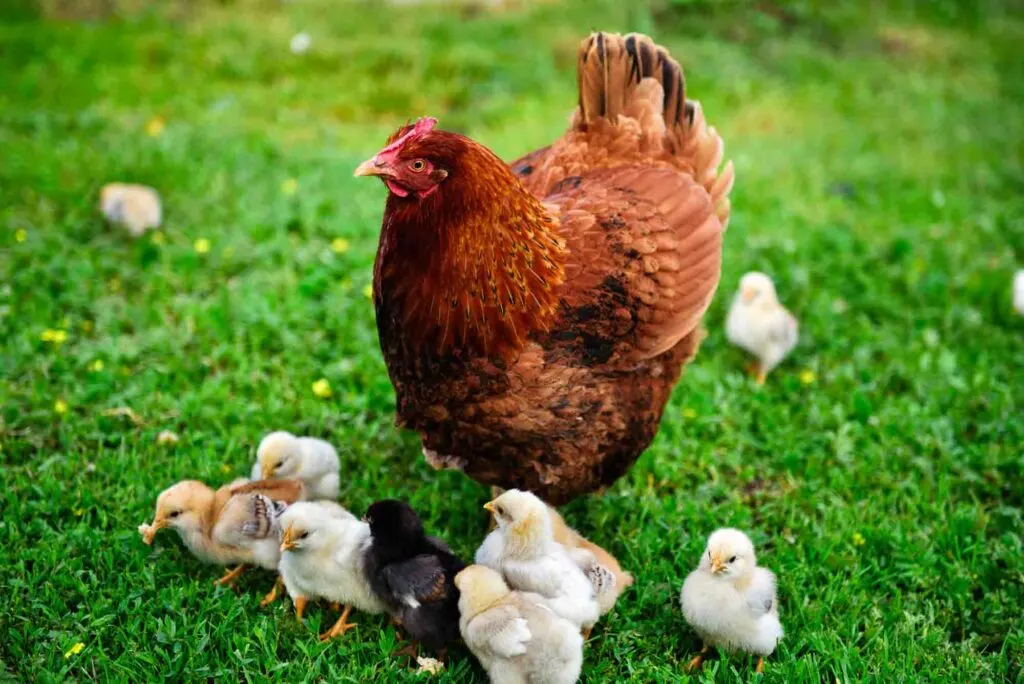
As you can tell from the name, the Rhode Island Red fit into the American class of chickens.
Note that the group name is always singular; it is never Rhode Island Reds, as that would refer to a soccer team rather than a type of chicken breed.
Although heavy Rhode Island Red chickens are well known as prolific egg layers, they are considered dual-purpose birds.
Roosters weigh around 8.6 pounds, while mature hens are significantly lighter and weigh about 6.6 pounds.
Rhode Island Red hens are excellent layers that can produce up to 300 brown eggs annually.
They are also cold hardy birds, so they are a good choice for poultry owners in the northern parts of the United States.
The Rhode Island Red was developed in Massachusetts, and the standard of perfection for the bird was approved in 1901. They have a single comb or rose comb, which is vivid red.
The state is so proud of its special breed of chicken that it is its state bird!
7. Cochin Chicken

Another giant of the Asian chicken group is the Cochin. Although it isn’t as popular as a meat or egg-producing bird, its physical attributes make it a sought-after choice as an exhibition bird.
Cochin chickens come in various colors, thirteen of which are accepted by the APA.
Approved colors include golden laced, red, birchen, buff barred, and blue. Besides their massive size, the most striking feature of cochin chickens is their feathered legs.
Because their legs are feathered, they are not always clearly delineated from their bodies; cochin chickens have the appearance of large solid tanks that seem to float over the ground.
Adult males weigh around 11 lbs. Hens are significantly lighter, and the average for a mature hen is 8.5 lbs.
Cochin hens are useful for poultry owners with other eggs that need incubation. These massive hens with feathery, warm feet are good setters and can also incubate turkey or duck eggs.
8. Black Copper Marans Chicken
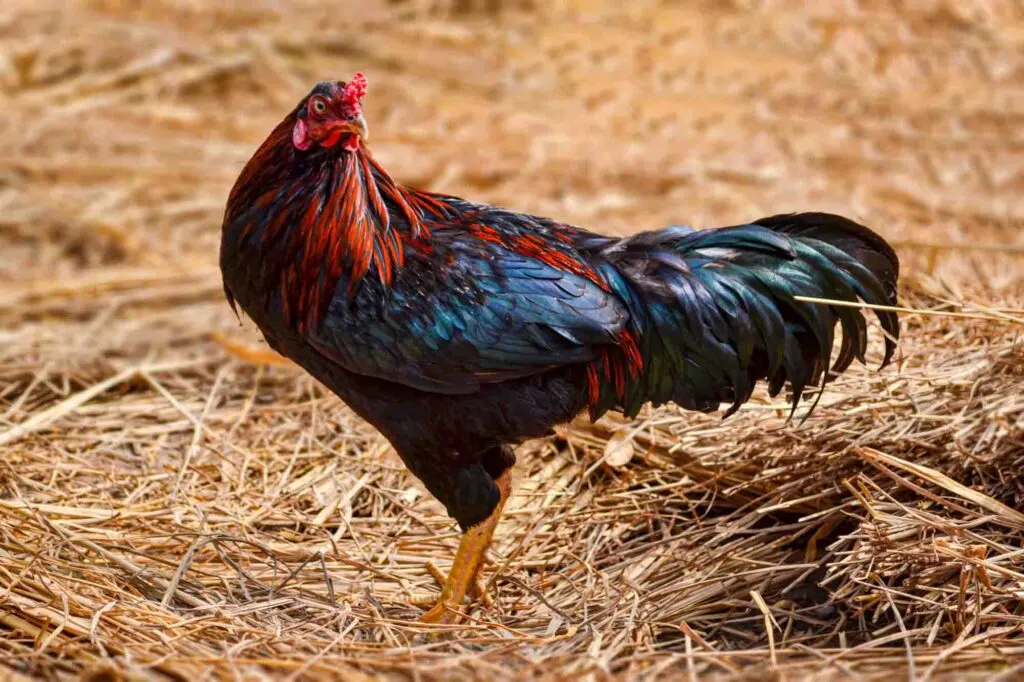
When speaking about Marans chickens, be sure to put on a French accent! The word Marans is pronounced Meh-ruhnz.
Marans is a region where this breed originates in France; the ‘s’ is part of the name. It is, therefore, never ‘maran,’ even if you only speak about a singular chicken.
Lively Marans chickens have a secret ability. They lay dark chocolate brown eggs – so dark that they are often called chocolate eggers.
The breed was brought into the spotlight when author Ian Fleming described his hero James Bond’s ideal breakfast as consisting of boiled French Marans eggs.
Marans fit into the Continental class of chickens, and they are excellent dual-purpose birds with good tolerance to extremes in temperatures.
Black copper Marans hens are surprisingly small and only weigh around 4.5 lbs. Roosters are considerably larger, and their average weight is 7.5 lbs.
9. Crevecoeur Chicken
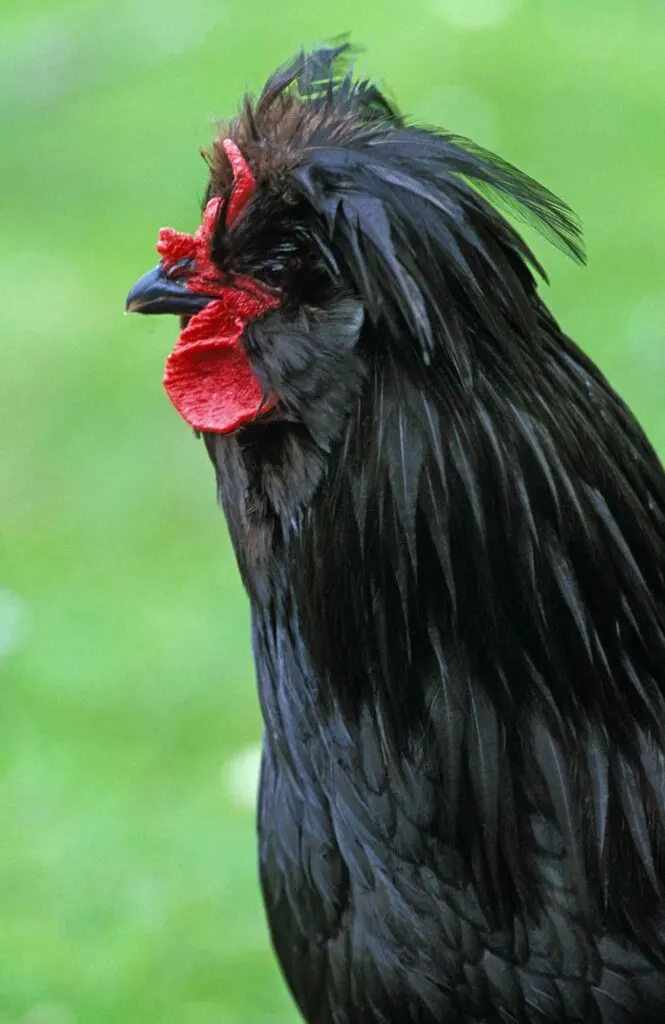
Not all endangered species are wildlife – some are also domestic animals. There are less than 1000 breeding Crevecoeur chickens in the entire world.
The origins of Crevecoeur chickens are so ancient that they are unknown.
What is known is that these chickens come from France, and while they were traditionally kept as dual-purpose birds, the two world wars virtually wiped them out.
Crevecoeur chickens are hard to miss. They are usually black; although there are other color variations in Europe, only the APA recognizes the black variety.
They have a distinctive bright red head crest and V-shaped comb, which stands out against their dark feathers.
Hens weigh about 5.5 lbs, and roosters are around 7.5 lbs. You are most likely to see Crevecoeur at poultry shows as they are mainly kept as exhibition birds by poultry fanciers.
10. Appenzeller Spitzhauben Chicken

The Appenzeller Spitzhauben is an extremely rare type of chicken originating from the Appenzell region of Switzerland.
It is so rare that in 2019 after a recovery project was launched several years before, there were less than 400 birds in existence.
The Appenzeller Spitzhauben is a unique-looking chicken. Roosters and hens sport long, almost pointed head crests; in fact, Spitzhauben means ‘pointy hat.’
Hens weigh around 2 pounds, and Appenzeller Spitzhauben roosters usually weigh slightly over 3 lbs.
These dainty chickens don’t manage well in confinement and are best left to free range. They will even roost in trees if given the opportunity.
The breed has several color variants, including silver and gold spangled. The silver-spangled variety is the most numerous.
Although there are a few Appenzeller Spitzhauben chickens in North America, they are extremely rare. The APA does not recognize the breed.
11. Cream Legbar Chicken
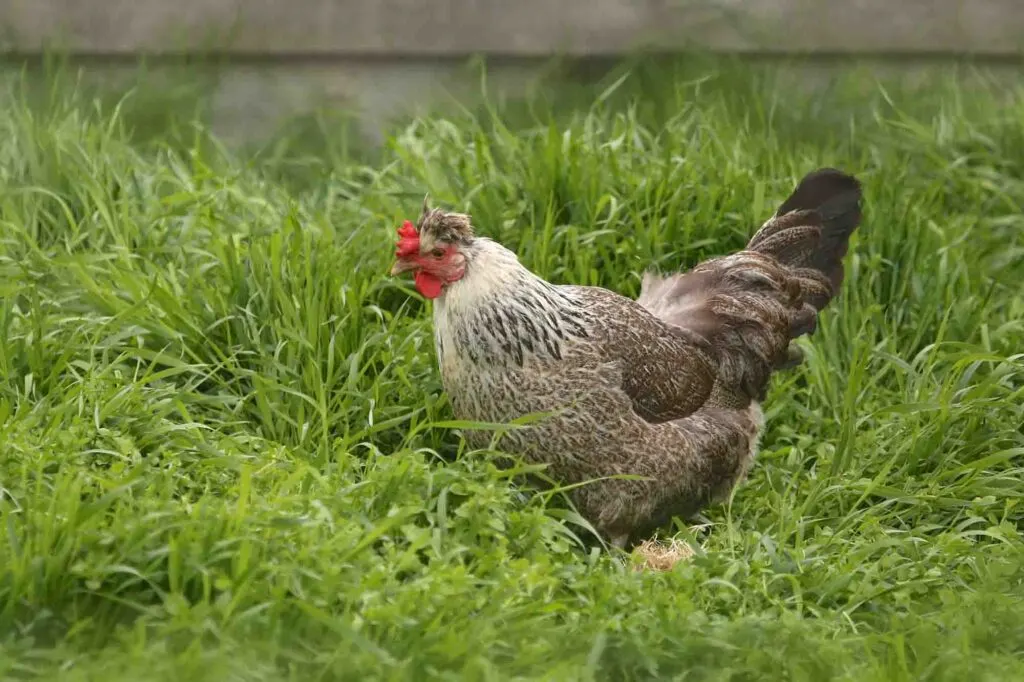
One of the biggest headaches for many poultry owners is not knowing whether chicks are males or females.
With many breeds, it is a case of waiting until the birds either start crowing or laying to know for sure.
That all changed when British geneticists developed an autosexing breed of chicken called a Legbar.
This means that rooster and hen chicks have noticeably different coloration when they hatch. Legbars were developed using Plymouth Rock and Leghorn chickens.
Cream Legbar chickens were the next step in this already almost miraculous process.
By adding Araucana chicken genes, cream Legbars were created, which are not only auto-sexing but also lay blue or green eggs.
A distinguishing physical characteristic of cream legbars is the prominent head crest which is a remnant from their South American ancestors.
They are not the most eye-catching type of chickens, but they are reliable layers that are happy to forage, and their dowdy color makes it easy for them to stay out of harm’s way.
Cream legbar hens weigh around 5.5 lbs, and roosters are 2 lbs heavier. This type of chicken is very rare in the United States.
12. Booted Bantam Chicken
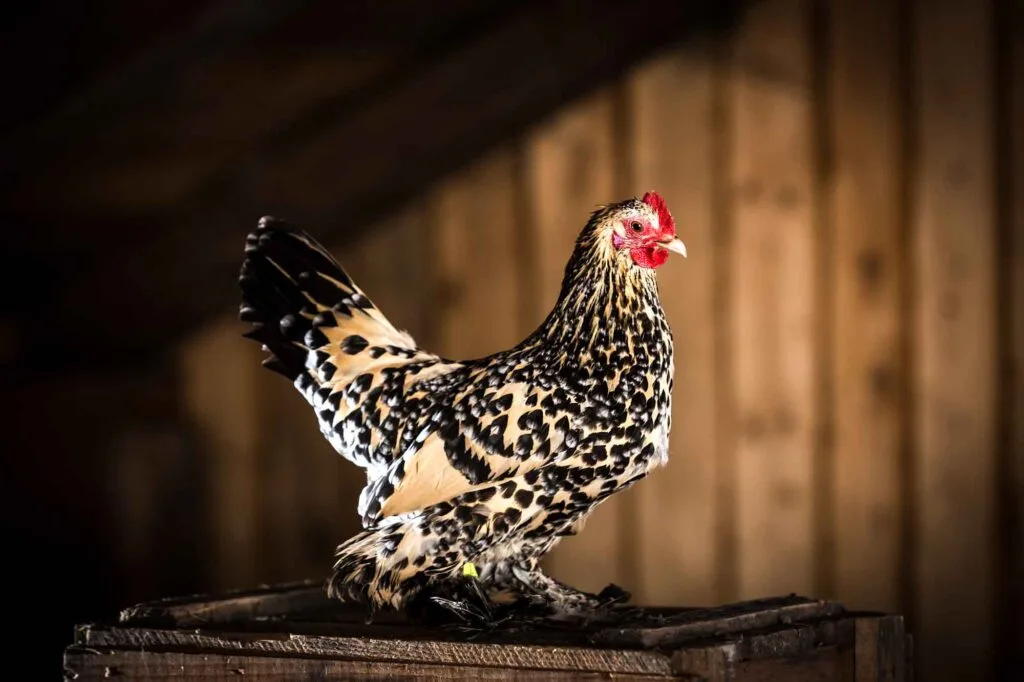
Another cute teeny tiny type of chicken is the booted bantam. Booted refers to the masses of feathering on their legs – it makes them look like they are wearing boots!
These are true bantams, as there are no standard-size birds like this.
Booted bantams are a European breed with their roots on the continent, but variations, including the black and white variety, were developed in the United Kingdom.
These small chickens are mostly kept almost exclusively for showing. The APA recognizes five color variants.
Roosters weigh around 1.75 lbs, and hens weigh about one and a half pounds. They are compact chickens with heavy leg feathering.
Not only are their legs covered in feathers, but they also have vulture hocks. That means they have extra, long, stiff feathers growing from their thighs that point straight down, almost reaching the ground.
13. Australorp Chicken

Out of all the heavy breeds, Australorps have one of the best track records for laying.
These shimmering black chickens that originate from Australia arrived in the United States in the 1920s and quickly became a sensation.
Australorp chickens are gentle giants that serve well as dual-purpose birds. They also excel in cold climates.
Mature hens weigh around 5.5 lbs, and roosters are much heavier and weigh about 8 lbs.
In their native country, Australia, Australorps are recognized in white, black, and blue varieties, but the APA has only approved the black type.
These large heritage breed chickens are excellent brooders and mothers, which is good news for poultry owners who want to increase the size of their flock naturally.
Australorp chickens have jet-black eyes and bright red wattles and combs.
Their light skin is, therefore, entirely unexpected, but it is noticeable by observing their bare legs, which seem pale against the intense beetle-green shimmer on their inky black feathers.
14. Brown Leghorn Chicken
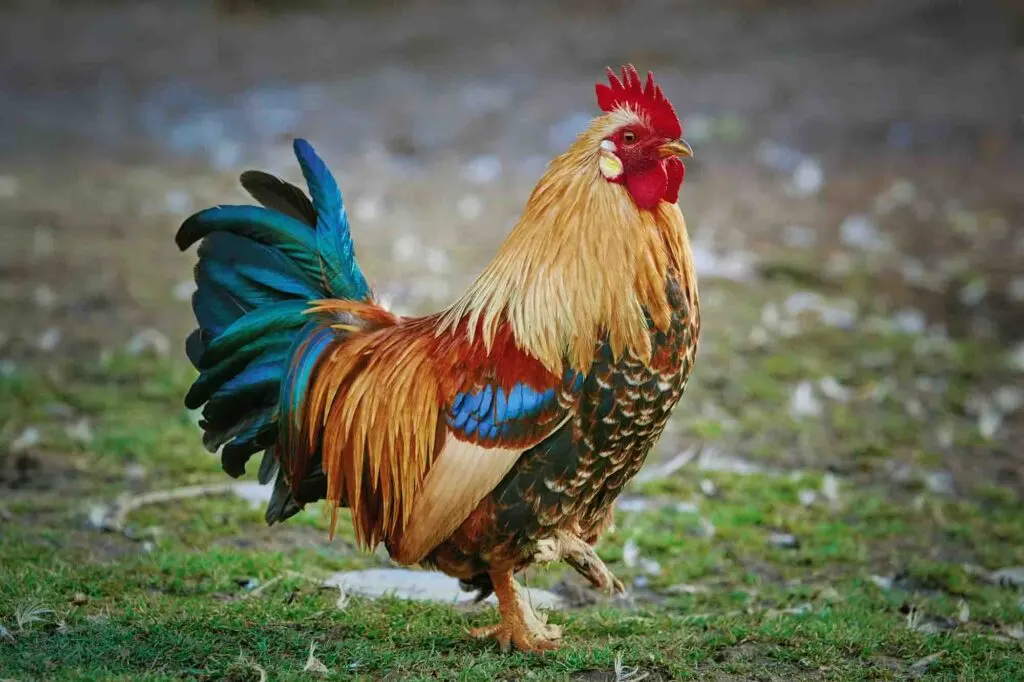
Leghorn chickens come in many color variants (like the white leghorn and so on), and the brown type is the most colorful of the family. Some are light brown, while others are a darker shade.
Brown leghorns were among the first to be admitted to the APA, which was back in 1974, so it is an established breed that has been a popular breed in the United States for a long time.
Brown leghorns fit into the Mediterranean class of poultry. Hens weigh an average of 4-5 lbs, and roosters can weigh up to 7 lbs.
Although they are a fairly average weight for chickens, they are not the best meat birds, and their primary purpose has been eggs.
Unfortunately, brown leghorns are not particularly friendly and prefer to get on with their independent lives.
They, therefore, don’t make good cuddly pets for children, but they are a hardy breed and hardworking hens that can lay up to 300 eggs a year if they are well looked after.
Brown leghorns seldom go broody, so it is difficult to hatch from home stock without an incubator or a surrogate mother from another breed.
Brown leghorn owners in colder states should choose the rose comb variety.
15. Ancona Chicken

Ancona is a city in Italy that gave its name to the distinctive breed of chickens that originated in the area.
Ancona chickens are an offshoot of back leghorns that sport white-tipped feathers, bright red wattles and combs, and distinctive white earlobes.
Like leghorns, Ancona chickens are popular as egg-producing chickens.
They are swift, enthusiastic foragers, and their mottled feathering makes them less of a target for predators than many other types of chickens.
Ancona chickens are a small breed. Hens weigh 4.5 lbs, and roosters can reach 6 lbs. Hens are excellent layers and produce a steady supply of small white eggs.
Feathering is always black with white tips on some feathers, but they are available in single or rose comb varieties.
16. Andalusian Chicken
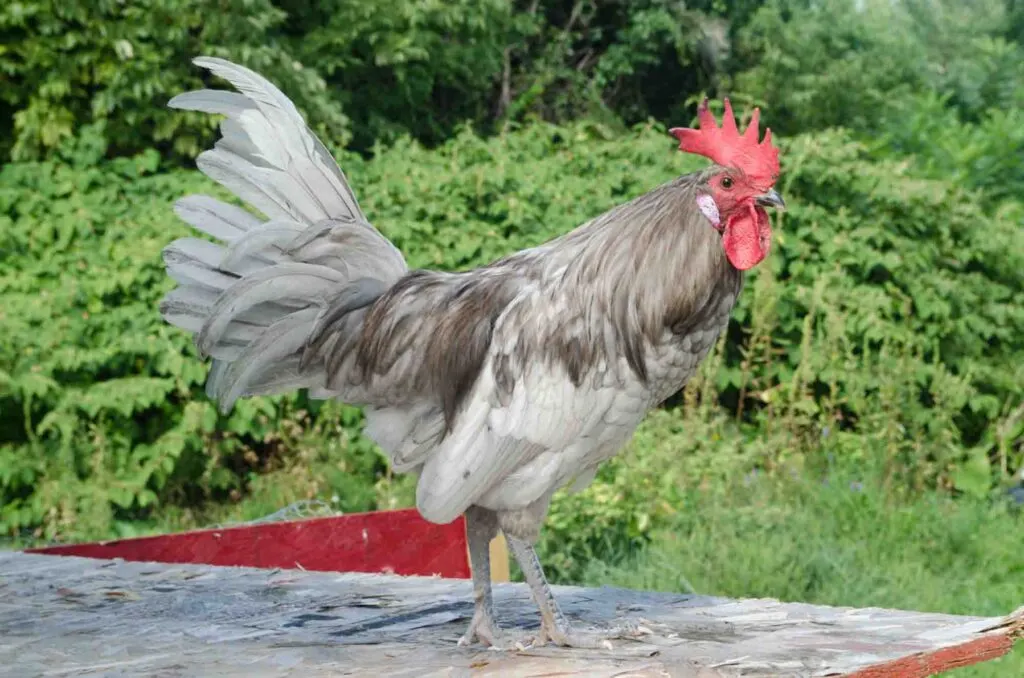
Andalusian chickens originate from Spain, and although the beautiful blue variety is exquisite, the breed is notorious for producing inconsistent colors.
While half the chicks in a batch may be blue, the other half could be mixtures of black and white.
Andalusian hens weigh 5.5 lbs, and roosters are around 7 lbs. This Meditteranean class of chickens is most commonly used as show birds.
Their dove grey color with a darker cape gives them an elegant, noble appearance.
Although Andalusian chickens are bred in the United States and the United Kingdom, it is never in great numbers.
Hens rarely become broody, but they are good layers. Their unstable color trait makes it difficult to produce excellent specimens.
17. Shamo Chicken
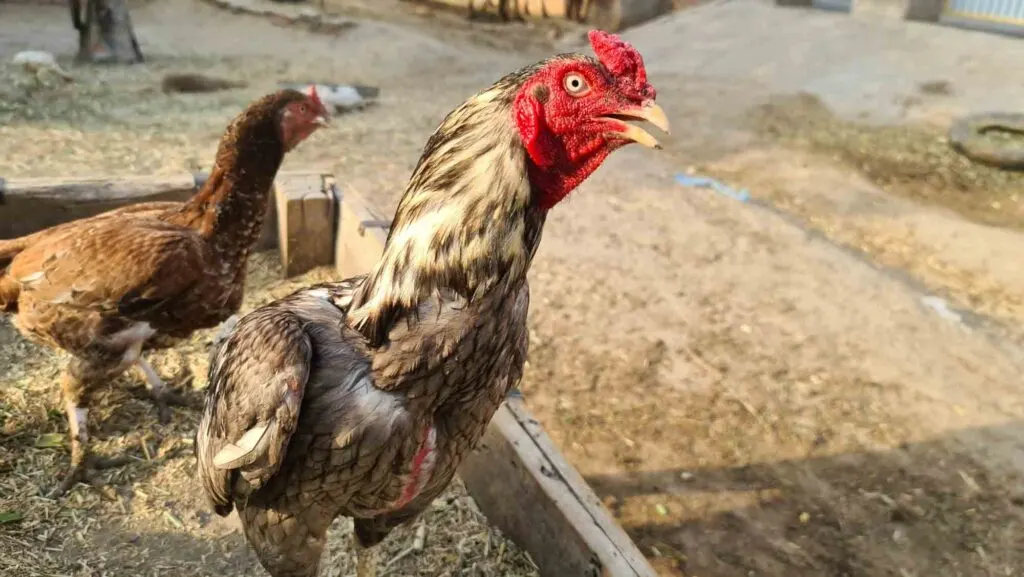
Shamo chickens have a convoluted history. These tall, slender birds originating in Thailand became popular in Japan in the 1600s as fighting birds and are thus classified as gamefowl.
Not all Shamo chickens are the same, and there are three distinct varieties. Roosters of the largest O-Shamo variety can weigh an average of 12.4 lbs, and hens around 7.5 lbs.
The medium-sized version is called Chu-Shamo and weighs between 6 and 8 lbs. Kimpa-Shamo are the smallest. Males weigh 4 lbs, and hens are 3 lbs.
Shamo chickens have a unique look. Unlike the rounded bodies of many other types of chickens, these well-muscled birds have long legs, an upright carriage, and an almost angry appearance.
Shamo hens are not good layers, and chicks hatch with an aggressive temperament. Male chicks often need to be separated to avoid fighting.
They are not good meat birds and are mostly kept as show birds or curiosities. The APA recognizes three varieties of Shamo chickens.
18. Egyptian Fayoumi Chicken
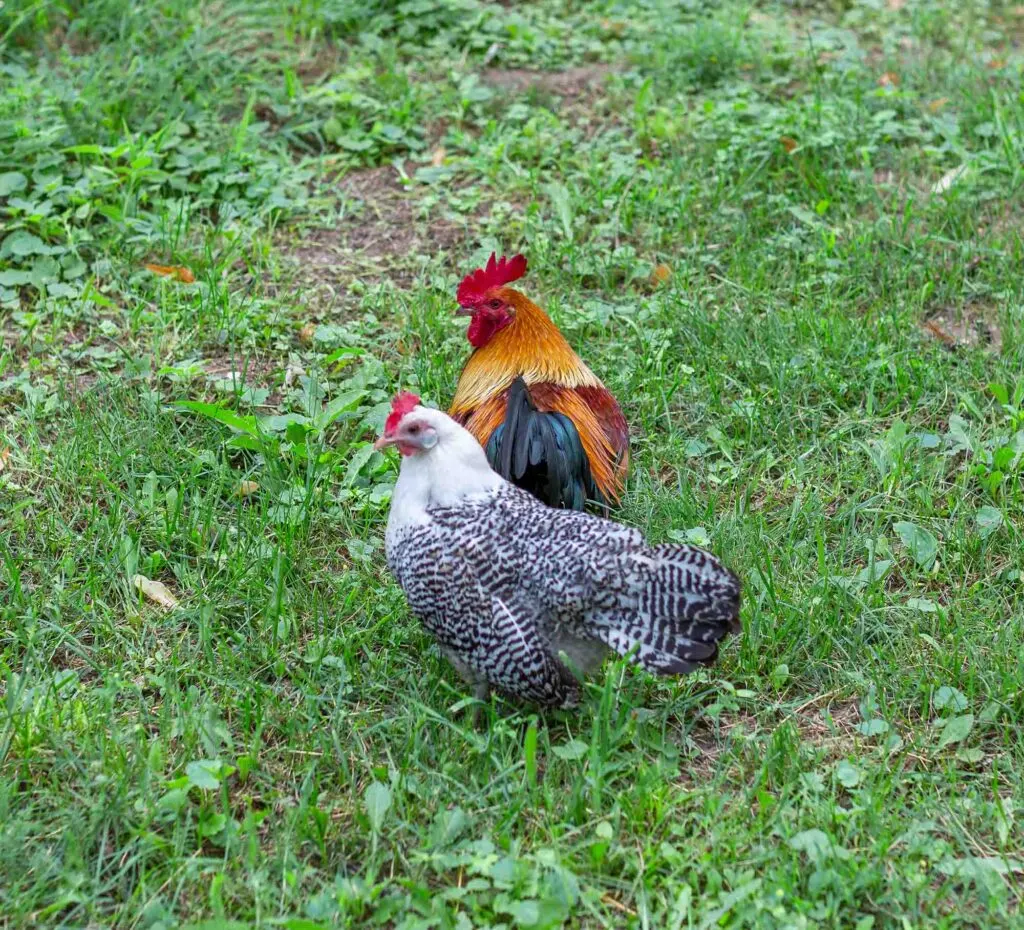
Not many people in the United States are familiar with Egyptian Fayoumi chickens. It is an ancient breed that is quickly winning hearts around the world.
A unique feature of these black and white chickens is the speed at which they mature. Roosters can start crowing before they reach two months of age, and pullets reach point of lay between 4 and 5 months.
They are a small breed. Egyptian Fayoumi hens weigh around 4 lbs, while roosters are only a pound heavier.
This type of chicken is suited to coping in warm climates and is happy to forage in a free-range environment. They are also naturally disease resistant, which is an excellent trait.
Although the APA does not recognize Egyptian Fayoumi chickens, they are neat, looking birds with attractive mottled feather patterning. Chicks are available on order from reputable breeders in the United States.
19. Araucana Chicken
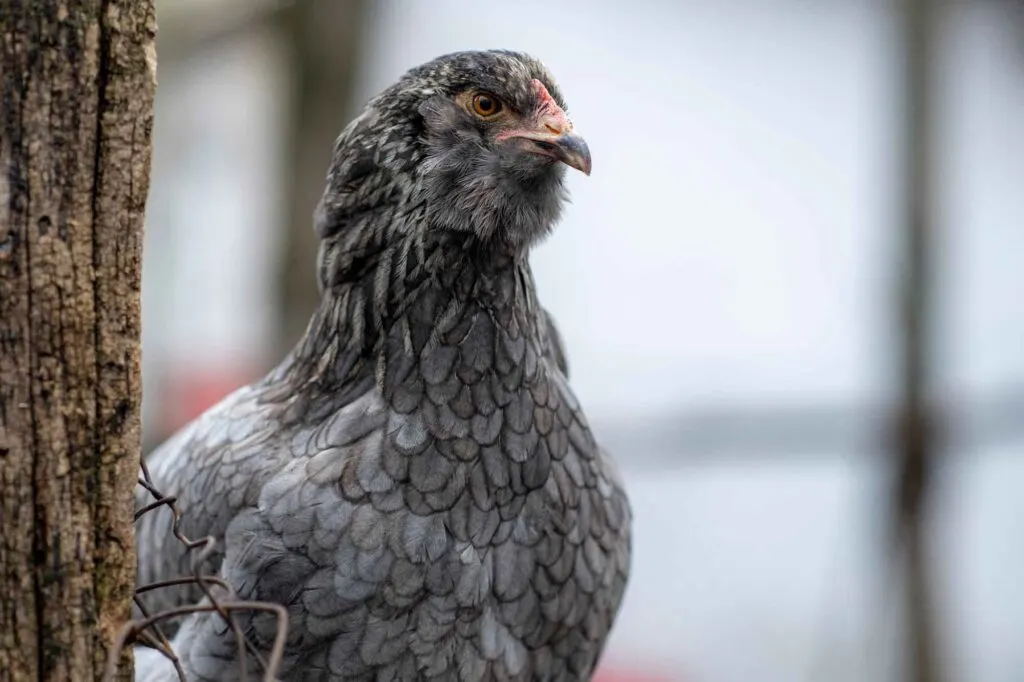
Hailing from Chile, the Araucana has become famous and infamous at the same time.
They are famous for laying beautiful blue-shelled eggs, but these rumpless, ear-tufted chickens carry a lethal gene that makes them difficult to breed as most embryos die before hatching and others soon after.
Five varieties of Araucana are recognized by the APA, and all of them are rumpless and have long ear tufts.
Araucana chickens have pea combs and are surprisingly cold-hardy for a breed that originates in South America.
Araucana hens weigh almost 6 lbs, and roosters can weigh up to 7 lbs. They make excellent backyard birds and are curious and friendly. Roosters are seldom aggressive.
Because breeding Araucana chickens is so challenging, two other breeds have developed from this type of chicken.
Ameraucana chickens are a recognized hybrid breed, while Easter Eggers are a hardy, merry mix of all sorts of chicken breeds that retain the ability to lay blue eggs.
Hey, did you like this article about the different types of chickens? Then share it on your social media!
Summary of 19 Different Types of Chickens
1. White Rock Chicken
2. Silkie Chicken
3. Barbu d’Uccle Chicken
4. Brahma Chicken
5. Langshan Chicken
6. Rhode Island Red Chicken
7. Cochin Chicken
8. Black Copper Marans Chicken
9. Crevecoeur Chicken
10. Appenzeller Spitzhauben Chicken
11. Cream Legbar Chicken
12. Booted Bantam Chicken
13. Australorp Chicken
14. Brown Leghorn Chicken
15. Ancona Chicken
16. Andalusian Chicken
17. Shamo Chicken
18. Egyptian Fayoumi Chicken
19. Araucana Chicken
